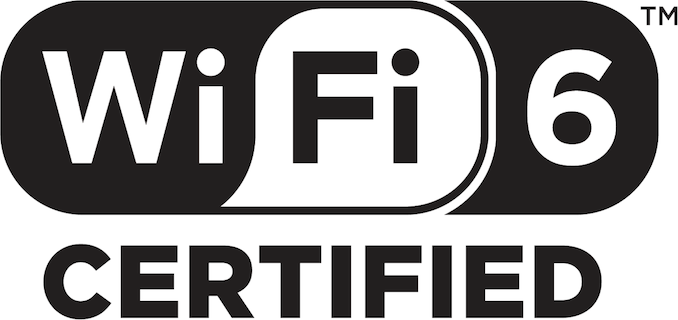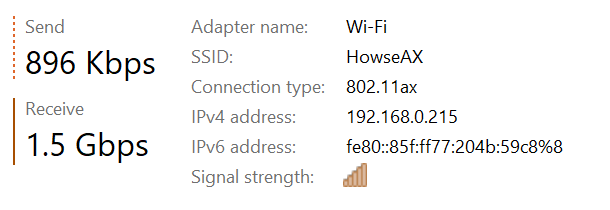AT 101: Wi-Fi 6 And Why You Want It
by Brett Howse on February 12, 2020 8:00 AM ESTTo The Future
If the question is do you need Wi-Fi 6, the answer is most assuredly “maybe”. The performance improvements are substantial, but really rely on a very strong signal to get the most data throughput. Most of the new features of Wi-Fi 6 focus on the influx of devices to the standard, and dealing with many devices connected to the same access point, or devices trying to share spectrum when connected to different access points.
The addition of Orthogonal Frequency Division Multiple Access to the Wi-Fi 6 standard will likely be the most impactful change to this revision. It will allow access points to carve up their channels into smaller slices, allowing more devices to communicate at the same time with less overhead. Each device will lose out on peak throughput, but the reduced latency should help a lot, especially in very dense environments. It should help with excessive overhead on the network layer when multiple devices are sending many small packets at once, which is a very common scenario, especially in an office or stadium situation.
Multi-User MIMO was in the Wi-Fi 5 specification as an optional implementation, and as such it did not really take off. Wi-Fi 6 should make this more prevalent, and also adds support to the MU-MIMO on the uplink, not just the downlink side. This will increase the capacity of access points for higher-speed use cases, but MU-MIMO did not get a lot of traction in Wi-Fi 5 so we will have to see how much adoption it gets in Wi-Fi 6.
The wider 160 MHz channels will offer significantly more throughput in the home environment, as we saw in our performance tests. As with the 1024-level QAM though, to see the biggest benefit you will need a strong signal. The vast majority of home networking is still limited to 1 Gigabit Ethernet, which puts Wi-Fi 6 into somewhat of an awkward spot, since it can transfer faster than most wired home networks, but even so, that is still a significant improvement over Wi-Fi 5 which would cap out around 600 Mbps on the best Wi-Fi adapters. If you work with a lot of large files, and you prefer to use Wi-Fi instead of the more consistent, yet cumbersome Ethernet, there’s still a nice boost to be had.
The future looks strong for Wi-Fi, and the Wi-Fi Alliance has made some excellent revisions to their standard to help improve Wi-Fi for the next generation of devices. As with any standards change, the impacts will not be seen right away. Both the access point, and the client need to be leveraging the new standard for the improvements to be noticeable. We’ve already seen the latest generation of smartphones start to offer Wi-Fi 6, and there’s been some movement in the PC space as well with Intel’s Project Athena. Anyone looking at a new router today should certainly opt for a Wi-Fi 6 model, but there’s likely not a major need for most people to move from Wi-Fi 5 access points right away. If you live in a heavily congested wireless area, the advantages of features like BSS coloring and Spatial Frequency Reuse should help out in those scenarios, but for people looking at purely performance, Wi-Fi 6 somewhat runs into a wall of its own making, since it can now transfer at over Gigabit speeds on a typical 2x2:2 connection. But who are we to question performance?












149 Comments
View All Comments
Makaveli - Wednesday, February 12, 2020 - link
Not quite that high.Ontario remained, by far, the most populous province in Canada with 13.4 million people calling it home in 2016, representing 38.3% of the Canadian population. This share was down slightly from the 100-year high of 38.5% in 2006.
So for american's you would consider Ontario the state.
And Ontario is a pretty big land mass 415,600 mi²
https://www150.statcan.gc.ca/n1/daily-quotidien/17...
Flunk - Wednesday, February 12, 2020 - link
Look up a population map, the vast majority of Ontario is sparsely populated, the area around Toronto & Hamilton is densely populated.andrewaggb - Wednesday, February 12, 2020 - link
In western canada your fastest options from the major providers are Telus gigabit 940/940 or Shaw Cable 600/20Neither needs more than a gigabit port. I'm sure telus could do faster but they aren't offering it.
mdrejhon - Thursday, February 13, 2020 - link
Buddy, something like ~25% of Canada lives within 2 hours drive of Toronto. There's millions of houses with access to gigabit connections.I'm in Canada and I'm on gigabit (Cogeco UltraFibe) and Bell is coming to lay fiber, so we'll have 2 gigabit ISPs competing in my city (lowly Hamilton)
Sure, if you go to the artic or the middle of our vast Canadian farmlands, it's crappy Internet. But if you go to populated Canada, there's lots of good Internet connections in urbanized Northeast Corridor now.
sonny73n - Friday, February 14, 2020 - link
“Canada is barely faster than Mexico”So they both have super fast internet compared to the where I live - the US. I only get 1.5 Mbps from the only ISP available in my area which is AT&T. Only basic internet available, no fiber. Don’t believe me? Open google maps and pick an address around Harbor Blvd. & Westminster Ave. CA. 92843. This is a super crowded area and we can only get 1.5 Mbps. All the subsidizes they got the government to upgrade their broadband towers have gone into their own pockets and the government do nothing. What a fucking joke.
Holliday75 - Wednesday, February 12, 2020 - link
Terrible for people in farmland sure. Got 100mbps around 12 years ago. 3 years ago I moved to a new ISP that uses FTTH. 500/500mbps for $70 a month. I can get 1gbps for another $20 a month, but see no reason for it. Even when downloading movies, large games, etc 500mbps is fast enough for me. Been quite pleased with it. Chicagoland overall has pretty good access to high speed offerings. Even the satellite cities are getting fiber now since prices on infrastructure has dropped so much the last 10 years.Dragonstongue - Wednesday, February 12, 2020 - link
say WHERE not just "in Canada" as I know am from and living in..Fiber is far far more promised than readily availableA
and
B
for the most part (meaning most of Canada) internet and telecoms overall are wickedly overpriced with moronic staging for the price point
lets see, get rid of majority of DSL that took a long time to even offer unlimited option, while also being on average ~$65/mth (including, sometimes without tax) for often sub 5/.768 connections, then they jack up price of standard phone lines (too expensive to maintain)
then they turn around pretty much make all other "we will call" high speed, sometimes 10/1 more often than not, lucky to stable 5/0.5, unless you were "very fortunate" to live in major city (even then) hit and miss STABLE above 20+DL 1-2UL ~$50-$110/mth plus tax only when in bundles.
Now they are wanting everyone on "wireless" to get away from all other types as although infrastructure is pricey (initially) after that, is dirt cheap to support thousands of customers per "tower" with few antennas to handle it (due to MIMO style)
when Fiber (which seems to be all over the country is actually "wired up" that would be one thing, but for now, generally quite overpriced (even when federal and provincial govt.) gave the telecoms many 10s of millions to "wire up the country by X date) and of course, things like CRTC seem to not give 2 shits.
...maybe because we all have full time bring in $100k per year in pocket jobs or something....yeh @#$ right.
as far as major ISP got rid of data caps in Canada years ago...I want some of that #$% you smoking, unless you the expensive (very limited) offerings, sorry, but no ALL telecoms in Canada still VERY MUCH have data caps....not everyone can afford $80+ per month internet PLUS phone + TV just to get the "unlimited" (to a point) bandwidth (data) allowance.
more often than not, folks living in Rural (which I currently do) NO LONGER have this option, unless you want to massively downgrade speed available, for the same price right around ~90 after tax.
folks should be far more "legit" in what they say (myself included) such as "I live in a condo in Vancover, or Montreal where internet is dirt cheap, sorry the rest of you @#$ do not"
^.^
Makaveli - Wednesday, February 12, 2020 - link
I live in Toronto.And I was a rogers internet customer for about 15 years I haven't had a data capped connection in 10+ years. I cannot speak for your experience.
And you sound like you suffer from living in a small town which is a problem the US shares. If you want good internet you are screwed living in Rural in North America, so either move or stay and deal.
Samus - Thursday, February 13, 2020 - link
Right, I have a Gigabit, full duplex (980/960) uncapped connection from AT&T Fiber for $70/mo in Chicago...I don't see any limitation of using a router with a Gigabit LAN port.Are there any beyond Gigabit ISP providers on the planet for residential use?
Willx1 - Thursday, February 13, 2020 - link
Minneapolis has had 10gbps fiber at $400/month for a while now. Not sure on specifics but they were apparently the first in the US to offer it to consumers.where I live with about 100k in the metro area (small area I know) in the city we are stuck with one cable provider midco. They do have fiber to the node but not the home because if cost, but a government subsidized company that offers ftth isn’t allowed in city limits and offer gbps speeds at much cheaper prices. In fact I worked for a company that did a lot of the underground work in the western half of my state and even the rural areas (including farms and ranches)have fiber to the home while the city centers don’t. So the times of rural areas either having satellite or dsl are long gone, at least in my state.